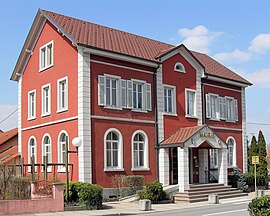| Dietwiller | |
|---|---|
| Commune | |
 The town hall in Dietwiller The town hall in Dietwiller | |
 Coat of arms Coat of arms | |
| Location of Dietwiller | |
  | |
| Coordinates: 47°41′31″N 7°24′07″E / 47.6919°N 7.4019°E / 47.6919; 7.4019 | |
| Country | France |
| Region | Grand Est |
| Department | Haut-Rhin |
| Arrondissement | Mulhouse |
| Canton | Brunstatt-Didenheim |
| Intercommunality | Mulhouse Alsace Agglomération |
| Government | |
| • Mayor (2020–2026) | Christian Frantz |
| Area | 11.06 km (4.27 sq mi) |
| Population | 1,399 |
| • Density | 130/km (330/sq mi) |
| Time zone | UTC+01:00 (CET) |
| • Summer (DST) | UTC+02:00 (CEST) |
| INSEE/Postal code | 68072 /68440 |
| Elevation | 240–304 m (787–997 ft) (avg. 250 m or 820 ft) |
| French Land Register data, which excludes lakes, ponds, glaciers > 1 km (0.386 sq mi or 247 acres) and river estuaries. | |
Dietwiller (French pronunciation: [ditvilɛʁ] ; German: Dietweiler) is a commune in the Haut-Rhin department in Alsace in eastern France. It forms part of the Mulhouse Alsace Agglomération, the inter-communal local government body for the Mulhouse conurbation.
History
The Thalbahn Habsheim ran through Dietwiller. It was a 24.6 km (15.3 mi) long narrow-gauge railway with a gauge of 600 mm (1 ft 11+5⁄8 in). It was built during World War I by German soldiers and Romanian prisoners of war as a military light railway. Many prisoners of war died due to malnutrition, forced labor and the poor living conditions and were buried in the Romanian cemetery in Dietweiler.
See also
References
- "Répertoire national des élus: les maires". data.gouv.fr, Plateforme ouverte des données publiques françaises (in French). 2 December 2020.
- "Populations de référence 2022" (in French). The National Institute of Statistics and Economic Studies. 19 December 2024.
- "Mulhouse Alsace Agglomération". Mulhouse Alsace Agglomération. Retrieved 2011-04-07.
- Paul Erhart: Histoire du chemin de fer militaire reliant la Hardt à Altkirch pendant la guerre 1914-18… Archived 2020-10-08 at the Wayback Machine
This Haut-Rhin geographical article is a stub. You can help Misplaced Pages by expanding it. |